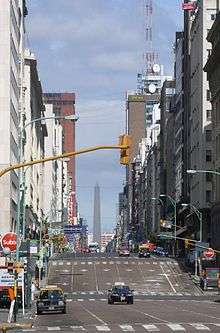
Avenida Corrientes
Avenida Corrientes (English: Corrientes Avenue) is one of the principal thoroughfares of the Argentine capital of Buenos Aires. The street is intimately tied to the tango and the porteño sense of identity. Like the parallel avenues Santa Fe, Córdoba, and San Juan, it takes its name from one of the Provinces of Argentina.
It extends 69 blocks from Eduardo Madero Avenue in the eastern Puerto Madero neighborhood to the West and later to the Northwest, and ends at Federico Lacroze Avenue in the Chacarita neighborhood. Automobile traffic runs from west to east. Line B of the Buenos Aires Metro runs most of its length underneath the street.
The Asociación Amigos de la Calle Corrientes ("Friends of Corrientes Street Association") is a group that collaborates on the urban planning of the street. They have placed commemorative plaques on 40 street corners bearing the distinguished figures from the history of the tango.
History
It was named Del Sol during the 17th century, San Nicolás from 1738 to 1808, and De Incháurregui from 1808 until 1822, when it received its current name. Never more than a street of average width during the nineteenth century, traffic swelled after the city began its rapid westward expansion, around 1880. Horse-drawn tramways first ran on the avenue in 1887; but, they soon proved inadequate and in 1910, Mayor Joaquín de Anchorena signed a bill authorizing its widening.

Corrientes
Corrientes (Guaraní: Taragüí, literally: "Currents") is the capital city of the province of Corrientes, Argentina, located on the eastern shore of the Paraná River, about 1,000 km (621 mi) from Buenos Aires and 300 km (186 mi) from Posadas, on National Route 12. It has a population of 328,689 according to the 2001 Census. It lies opposite its twin city, Resistencia, Chaco.
It has a mix of colonial and modern architecture, several churches and a number of lapacho, ceibo, jacaranda and orange trees. It is also home to one of the biggest carnival celebrations in the country.
The annual average temperature is 20 °C (68 °F), with maximum and minimum averages of 45 and 5 °C (113 and 41 °F) respectively. The annual rainfall is around 1,200 millimetres (47 in).
Transportation
The General Belgrano Bridge crosses the Paraná River that serves as the natural border with the neighbouring Chaco Province. On the other side of the bridge is Resistencia, capital of Chaco. To the west and up the Paraná, between Paraguay and Argentina, lies the Yaciretá dam, one of the largest hydroelectric power generators in the world.

Corrientes (Buenos Aires Underground)
Corrientes Station is a station on Line H of the Buenos Aires Underground that served as the line's north terminus from 2010-2015 until the next extension of the line was completed in late 2015. From here, passengers may transfer to the Pueyrredón Station on Line B.
References
External links
![]() Media related to Corrientes (Line H Buenos Aires Underground) at Wikimedia Commons
Media related to Corrientes (Line H Buenos Aires Underground) at Wikimedia Commons
Corrientes (disambiguation)
Corrientes (chains or currents in the Spanish language) can refer to:
Podcasts:

